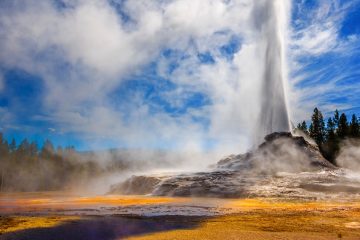The Wild West Awaits: 13 Ghost Towns in America You Can Still Explore
Kennecott, Alaska
While many ghost towns were founded during the gold rush, Kennecott, Alaska was once a prosperous copper mining camp. Established in the early 1900s, Kennecott yielded one of the richest copper deposits ever discovered, and quickly became a thriving town.
At the peak of the mine’s operation, about 600 men worked within the mines and the local mill. Although the town was primarily populated by miners, it was important to those who brought their families to establish a growing community. The town included a school, skating rink, tennis court, recreation hall, general store and hospital.
In the 1920s the supply of ore was diminishing, and the Copper Corporation expanded elsewhere. The deserted remains of the town have been left empty for over 60 years. The camp and abandoned mines are now a National Historic Landmark acquired by the National Park Service. Several
structures remain today; some have been repurposed for modern use such as the store and the post office, while others need additional stabilization to keep them from further deterioration, and still others have decayed and rotted beyond repair.
The Kennecott ghost town is open to the public throughout the summer. The visitor center can provide brochures, backcountry trip planning, history talks, wilderness excursions, and nature walks in addition to information about the mining town.

Animas Forks, Colorado
Roughly 12 miles northeast of Silverton, CO three rivers meet, one of which is the Animas River. In 1873, prospectors built the first cabins of a town called Three Forks of the Animas, soon renamed Animas Forks. By 1876 it was a bustling mining community complete with a general store, post office, local newspaper, hotel and dozens of cabins. Nearly 500 people called Animas Forks home by 1883.
At the turn of the century the mine’s profits started to decline, and residents left the town behind. By the 1920s, Animas Forks was officially a ghost town.
Animas Forks still exists as a tourist attraction and while it isn’t the easiest ghost town to get to, it does provide plenty of adventure. If you have a two-wheel drive vehicle, the town is only accessible in the summer as getting there requires navigating a system of dirt roads called the Alpine Loop. The fragile state of the buildings means visitors are prohibited entry, but exploring the surrounding area can make for an exciting day trip and stunning photos. Take note that journeying along the road past Animas Forks will require a four-wheel drive vehicle. Brochures and maps of the town are available in the main parking area.
Ancient dwellings and stunning landscapes await you in Turkey. This guide to Turkey tourism will help you discover it all while on your trip.

Calico, California
Calico was once a grand mining town during the largest silver strike in California. With roughly 500 mines, Calico produced over $20 million in silver ore, but once silver lost its value in the mid-1890s, the residents packed up and abandoned their town.
The ghost town was purchased in the 1950s by Walter Knott who restored all but five of the original buildings to their original state. Today Calico is a State Historical Landmark and part of the San Bernardino County Regional Parks system and offers several tours and attractions.
Over the years, the town of Calico, CA has earned its ghostly title with a series of reported paranormal activity. Ghost tours are available through the town on weekends and become a popular attraction during the month of October when they host Fear Town. Calico ghost town is open 9 a.m. to 5 p.m. every day, except Christmas Day. Tour and attraction prices vary per package.






